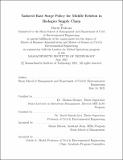Tailored Base Surge Policy for Middle Echelon in Biologics Supply Chain
Author(s)
Pedroni, David
DownloadThesis PDF (1.619Mb)
Advisor
Roemer, Thomas
Simchi-Levi, David
Terms of use
Metadata
Show full item recordAbstract
The Biologics division of AstraZeneca is a growing part of the business, by introducing new and existing products to more markets and therapy areas. Given uncertainty in both supply and demand, the current strategy includes holding inventory at strategic locations throughout the supply chain to ensure customer access to medicines. While using inventory to manage supply and demand variation is common practice, the impacts on working capital can be significant, especially for products with strong growth trajectories, long lead times, and numerous stages of manufacturing.
For strategically selected products, AstraZeneca generally elects to qualify multiple manufacturing sites to mitigate some of the supply risks associated with unplanned events ceasing production for extended periods of time. The AstraZeneca standard strategy for products with multiple sourcing could be described a form of quota arrangement, where each upstream manufacturing site will supply a portion of customer or next-stage manufacturing site orders. From a medical-supply perspective, the overarching objective is to provide high quality product to meet all customer demand. The secondary objective is minimizing supply cost, but not at the expense of risking quality or service. The primary focus of this thesis work is to evaluate the opportunity of implementing a tailored base-surge policy (TBS) for multiple-sourced global products. A TBS policy would generally leverage differences in manufacturing site lead time characteristics to deliver a high level of service with less inventory. In a global market, a quota arrangement policy generally is less complex while TBS takes advantage of pooling demand variability at the most responsive site.
The approach will begin by reviewing two products manufactured at a responsive, internal site as well as at an external supplier. The evaluation will benchmark a quota arrangement strategy and compare the analytically recommended inventory levels. In addition to this primary inventory driver, regulatory approvals, cost of goods manufactured, and supply constraints will all be considered. After performing this detailed analysis for a single stage of manufacture, the objective is to generalize the process and identify key supply chain characteristics that would suggest TBS would be effective in reducing inventory. This general approach will assist in future decisions to decide between a quota arrangement strategy and a tailored base surge policy.
Date issued
2021-06Department
Sloan School of Management; Massachusetts Institute of Technology. Department of Civil and Environmental EngineeringPublisher
Massachusetts Institute of Technology